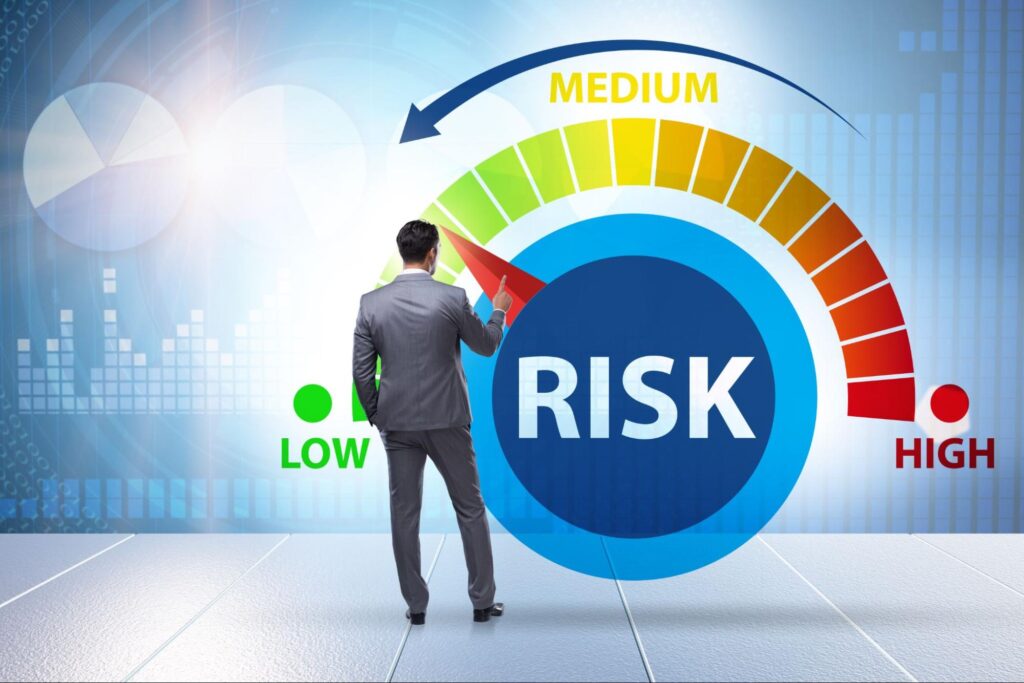Introduction: Understanding Risk in the World of Crypto
Risk management is the cornerstone of any effective trading strategy, especially in the cryptocurrency market, which is known for its extreme volatility and unpredictability. Unlike traditional markets, crypto trading operates around the clock and is subject to rapid price changes that can lead to significant losses. Risk management involves identifying, assessing, and taking steps to mitigate these potential losses, ensuring that traders protect their capital and approach trading with a calculated, disciplined mindset.
In the world of crypto, effective risk management is essential for both beginners and experienced traders. It allows them to trade with confidence, make informed decisions, and weather the ups and downs of a volatile market. By embracing risk management, traders can create a sustainable strategy that reduces the likelihood of catastrophic losses and increases their long-term potential.
1. The Unique Risks of Crypto Trading
Volatility and Price Swings
Crypto markets are famously volatile, with prices that can swing by double-digit percentages within hours. This volatility can result in both rapid gains and sudden losses, requiring traders to stay vigilant and adopt strategies to mitigate these swings. Even established assets like Bitcoin and Ethereum experience significant fluctuations, while smaller altcoins are even more prone to wild price variations.
Regulatory and Security Risks
Crypto is still in a regulatory gray area in many regions, and changes in regulations can have a profound impact on the market. Sudden announcements from governments, bans on crypto trading, or changes in tax laws can trigger dramatic price movements. Additionally, crypto assets are vulnerable to security risks like hacking, fraud, and phishing scams. Without the protection of centralized institutions, traders need to adopt personal security measures to safeguard their assets.
Liquidity and Market Manipulation Concerns
The crypto market is also known for liquidity issues, especially with lesser-known tokens. Low liquidity can lead to slippage, where orders are filled at unexpected prices, and increases susceptibility to market manipulation. Pump-and-dump schemes, where prices are artificially inflated and then sold off, are still common, emphasizing the need for caution and risk awareness.
2. Core Principles of Risk Management
Preserving Capital Over Maximizing Profit
In crypto trading, the focus should be on preserving capital rather than chasing maximum profits on every trade. Preserving your initial investment allows you to continue trading and learning over time. Remember, taking a small, manageable loss is far better than a devastating one. The key to longevity in trading is to make calculated decisions that prioritize sustainable growth.
Diversifying Investments and Managing Exposure
Diversification is an essential part of risk management. By spreading investments across different assets, you reduce the impact of a single asset’s downturn on your portfolio. Many traders apply the 5% rule, which means not allocating more than 5% of their portfolio to any one asset. Managing exposure minimizes risks associated with individual assets and ensures a balanced approach.
The Role of Planning and Discipline in Risk Management
A disciplined approach to trading starts with a solid plan. This includes establishing entry and exit points, determining the maximum amount you’re willing to lose, and setting profit-taking targets. Consistency is vital—sticking to your plan prevents impulsive decisions and enables you to make objective choices regardless of market conditions.
3. Popular Risk Management Strategies for Crypto
Position Sizing and Its Importance
Position sizing is a strategy to determine the amount of capital to allocate to a trade. By only risking a small percentage of your portfolio (often 1–2%), you limit the impact of a single losing trade on your overall holdings. This conservative approach helps maintain stability and reduces the emotional strain of significant losses.
Setting Stop-Loss Orders and Take-Profit Targets
Stop-loss orders allow traders to set a predetermined price at which an asset will be sold if it starts to decline, limiting potential losses. Similarly, take-profit targets automatically sell an asset once it reaches a certain level of profit. These tools prevent trades from turning unprofitable due to market reversals and remove the guesswork during volatile swings.
Hedging Strategies and Their Application in Crypto Markets
Hedging is a technique used to offset potential losses by taking a position that moves in the opposite direction of your main investment. For example, if you own Bitcoin and anticipate a downturn, you might short Bitcoin or buy a stablecoin to preserve value. Hedging is a way to protect against significant losses, though it may not be suitable for all traders due to its complexity and additional costs.
4. Tools and Techniques for Assessing and Managing Risk
Portfolio Diversification and Asset Allocation
Diversifying your portfolio is a core strategy in risk management, helping to spread exposure across assets with varying risk profiles. This might include a mix of top cryptocurrencies like Bitcoin and Ethereum, mid-tier tokens, and stablecoins. Asset allocation can be adjusted depending on risk tolerance, with higher proportions in safer assets for conservative traders and a smaller percentage in volatile altcoins for those with a higher risk appetite.
Understanding Risk-Reward Ratios
The risk-reward ratio is a simple tool that measures the potential profit of a trade against its possible loss. For example, a 3:1 ratio suggests a trade could bring three times as much profit as it could risk losing. By only entering trades with favorable risk-reward ratios, you set yourself up for potential success over the long run, as winning trades can offset a series of smaller losses.
The Importance of Keeping a Trading Journal for Insights
A trading journal is a valuable tool for assessing your trades and understanding patterns in your behavior. By tracking each trade’s outcome, rationale, and emotional factors, you gain insights that can improve your decision-making. Over time, this journal becomes a personalized guide, helping you identify which strategies work and which need adjustment.
5. Emotional Control and Its Role in Risk Management
Recognizing Emotional Triggers Like FOMO and Panic Selling
Fear of missing out (FOMO) and panic selling are common emotional pitfalls in crypto. FOMO often arises during market rallies, leading traders to buy in at inflated prices, while panic selling typically happens in response to sudden drops, locking in losses. Recognizing these triggers is the first step in controlling emotional responses and avoiding impulsive decisions.
Techniques to Stay Calm and Make Logical Decisions
Adopting strategies like setting fixed entry and exit points helps minimize emotional interference. Mindfulness and stress management techniques—like deep breathing and taking breaks from screens—can also improve decision-making. Practicing these techniques will lead to more rational, strategic trades, even during turbulent market conditions.
Building Resilience Through Mindfulness and Routine
Trading can be emotionally taxing, especially in crypto. Creating a trading routine, such as starting each day with market research and a clear plan, reduces emotional variability. Mindfulness practices can further build resilience, allowing traders to approach each session with a clear, focused mind and a reduced likelihood of impulsive reactions.
6. Learning from Losses: The Growth Mindset in Risk Management
How to Assess and Learn from Unsuccessful Trades
Losses are inevitable in trading, but each loss offers an opportunity to learn. Rather than ignoring mistakes, take the time to analyze each losing trade: Did you set the right stop loss? Was your position size too large? By objectively assessing losses, you gain insights that strengthen your approach over time.
Building Experience as a Path to Better Decision-Making
Risk management skills improve with experience. As traders learn from both wins and losses, they develop a stronger sense of what works and what doesn’t. This experience translates into better decision-making, as you begin to recognize patterns and adjust strategies based on a more informed understanding of market behavior.
Developing a Personal System to Measure and Improve Your Risk Management
Creating a set of personalized metrics—like average win/loss ratio, number of trades per week, and percentage of successful trades—enables you to track your progress over time. This system gives you a quantitative measure of your risk management effectiveness and highlights areas for improvement.
7. Common Risk Management Mistakes in Crypto
Over-Leveraging and the Dangers of High-Risk Trades
Leverage can amplify gains but also magnifies losses. Over-leveraging is a common mistake that leads many traders to catastrophic losses, especially in crypto where price swings are frequent. Beginners are often encouraged to trade without leverage until they’ve developed a solid understanding of the market.
Ignoring Research and Blindly Following Market Trends
Relying solely on market hype without conducting personal research is a risky approach. It’s crucial to understand the fundamentals of each asset, including its project goals, team, and potential use cases. Avoid trading based on speculation alone, as this can lead to costly mistakes.
Failing to Adapt to Changing Market Conditions
Crypto markets evolve rapidly, and strategies that work well in one market cycle may fail in another. Being adaptable means revisiting your risk management approach regularly, adjusting based on new trends, regulatory developments, and personal experiences.
Risk Management as a Foundation for Long-Term Success
Risk management isn’t just a tool—it’s the foundation of a sustainable trading strategy. By focusing on capital preservation, using tools like stop losses and diversification, and controlling emotional reactions, traders create a framework that supports consistent growth and resilience. In a world as unpredictable as crypto, a robust risk management strategy can help you stay on course, protecting your assets and helping you build confidence over time. Embrace risk management not as a limitation, but as a strategy that empowers you to trade with confidence and clarity.














